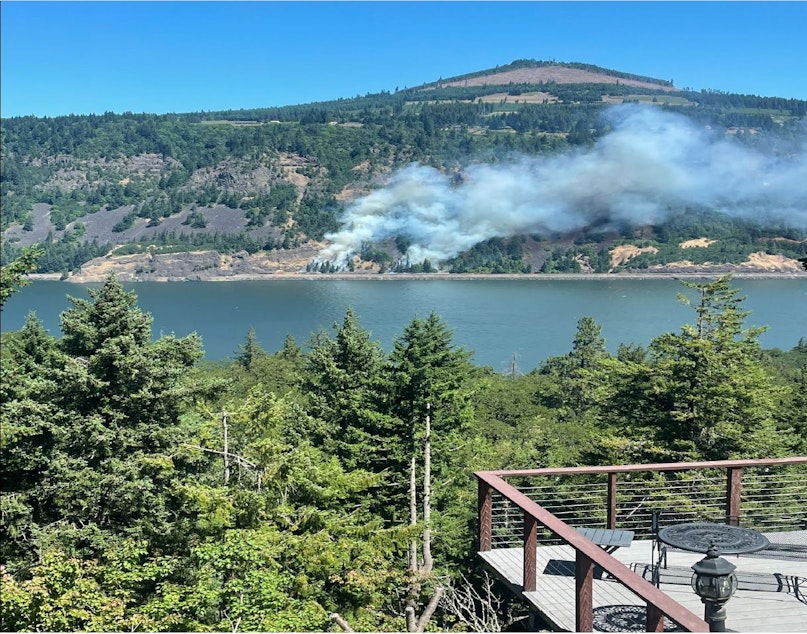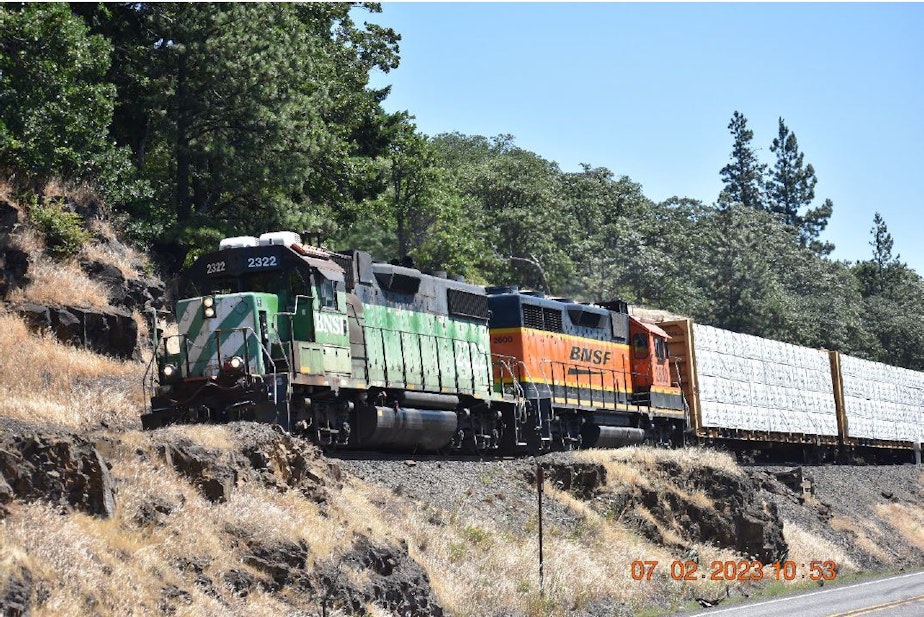Fire-prone old BNSF train ignited 500-acre Columbia Gorge blaze, state finds

Chunks of hot carbon and lubricant pads spewed from a 1970s-era BNSF Railway locomotive caused a wildfire in southern Washington in July, according to an investigation from the Washington Department of Natural Resources.
The Tunnel 5 fire in the Columbia River Gorge burned 546 acres and destroyed 10 structures before it was put out on July 14, two weeks after it ignited beside BNSF Railway tracks in Skamania County west of White Salmon.
A Department of Natural Resources fire investigation, first reported by Columbia Insight, ruled out lightning and other possible ignition sources. The agency blamed a BNSF train that carried lumber toward the railway’s Tunnel 5 about 15 minutes before various 911 callers reported seeing flames amid the grass and dry brush beside the tracks.
“This train emitted some object(s) which started fire in three areas over an [approximate] 690-foot distance, all on the north side of the tracks,” Department of Natural Resources investigator Bruce Long concluded.
Long found 1- to 2-inch chunks of carbon—oversized exhaust particles from a diesel engine—and more than 70 scraps of train-wheel lubrication pads in or near the three spots where the fire broke out.
“No other evidence was located which can explain the three simultaneous fires starting within the same time frame and inside this 690-foot-long area, all on the north side of the BNSF tracks,” Long wrote.
On the Sunday morning when the fire started, Richland resident Bryan Baller and his teenage son spotted an unusual locomotive heading for Tunnel 5 in the Columbia Gorge: a BNSF engine in green and white instead of the usual orange and black.

The father and son share a hobby of photographing unusual, older trains. Bryan Baller, a Union Pacific engineer, knew this engine was at least 40 years old, likely with an older, non-turbocharged engine prone to emitting hot globs of carbon in its diesel exhaust.
(Locomotive 2322 was 46 years old, built in 1976, KUOW was able to confirm.)
They shared their photos and observations with the fire investigator.
“Being a non-turbocharged engine, it has a high likelihood of emitting diesel carbon emissions from the exhaust which could start a fire,” the investigation states. “Baller added that it was UP practice to not use these older non-turbocharged engines in the Columbia Gorge during summer months due to their propensity to start fires. UP primarily used these older engines within train yards/depots, and not out on open tracks in summer months.”
BNSF Railway is still reviewing the DNR’s findings, according to BNSF spokesperson Lena Kent.
Kent declined to be interviewed.
“It is worth noting that this location is adjacent to a highway and that the incident occurred just before Fourth of July,” she said in an email. “That being said, we are committed to reducing the risk of fires around our tracks and equipment.”
Kent did not directly answer KUOW’s written questions: Why was BNSF using a high-fire-risk engine there? Does BNSF have plans to stop using such (older, non-turbocharged) engines in areas with high fire risks?
Instead, Kent listed various measures BNSF takes to prevent and respond to fires.
“We clear brush, cease hot work activities during periods of high winds or unpredictable gusting wind, use spark shields, pre-wet the work environment when needed, and designate fire watchers to be able to react quickly in the event of a fire. We also have tank cars full of water pre-staged in areas prone to fire conditions,” Kent wrote.
A BNSF firefighting train, with tanker cars able to spray 64,000 gallons of water, fought the Tunnel 5 fire from the tracks, but the flames were able to spread up a steep hill heading north from the railway.
In older engines like Locomotive 2322’s 2,000-horsepower, two-stroke engine, oil can wind up in the exhaust and form carbon deposits that get knocked loose when the engine revs up, according to Herb Krohn with the International Association of Sheet Metal, Air, Rail and Transportation Workers. The union represents BNSF engineers and conductors.
“The extra heat and gas velocity in the exhaust start knocking these deposits loose, sending red-hot embers up and out of the exhaust stack,” Krohn said in an email.
Older locomotive engines have “traps” designed to stop hot oil or chunks of hot carbon from escaping, but they require frequent maintenance to work properly, Krohn said.
He said BNSF once had a policy to check traps more often during summer months because of wildfire concerns.
“Given BNSF's current trend of shutting down locomotive servicing shops and reducing maintenance forces, it is highly doubtful these preventive maintenance activities are actually being carried out any longer,” Krohn said.
According to the Department of Natural Resources investigation, sparks from a BNSF track grinding machine had started brush fires just east of the Tunnel 5 fire five and eight days earlier.
“These two track maintenance fires occurred during hours of darkness when temperatures would have been cooler and humidity higher. A localized fire danger along the tracks in this general area should have been known to BNSF,” the investigation concludes.
Another witness told Long a BNSF track-grinding machine “showered his vehicle with sparks” as he drove along State Route 14 parallel to the BNSF tracks near Tunnel 5 on June 27.
“He was somewhat familiar with the area and knew the vegetation to be very dry," Long said. "He thought it was dangerous for BNSF to be track grinding in these conditions.”

